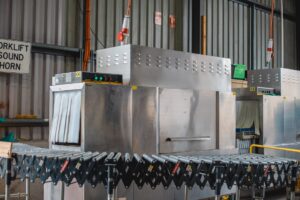Industrial Uses of Process Steam
Last updated on May 8th, 2025 at 05:23 am
Cost-effective and efficient, process steam has excellent heat transfer capabilities with low toxicity. As a result, steam is widely used in industrial processes, manufacturing, and heating.
The use of electric process steam heaters maximizes steam’s inherent efficiency and cost-effectiveness. This article discusses steam generation and common industrial uses of process steam.
Steam Generation
Depending on its purpose, processes may apply direct or indirect steam for a given project. The most efficient method is generally direct steam using an electric boiler heater.
The flanged elements of the boiler heater are submerged in the boiler, allowing for direct heat application. The direct application reduces the time and energy required to generate steam. Using electric immersion heaters further extends these benefits as they can achieve higher temperatures faster and with lower energy consumption.
Indirect steam is less efficient but effective when contact with the steam could cause exposure or contamination issues. One method of this is using a combination of a heat exchanger and hot oil. A circulation heater is an effective way to achieve and maintain the target oil temperature.
Steam Purity
There are several types of process steam. They break down primarily into either saturated or superheated steam. The most common is utility steam, a subclass of saturated steam; it’s cheap to generate and uses conventional boilers. On the other hand, Superheated steam is mainly used in power generation.
While utility is sufficient for most applications, some projects require specific purity levels. Pure and clean steam have stricter boiler heater materials, temperatures, and feedwater quality regulations. Clean steam is used for many pharmaceutical applications, while pure steam offers the highest level of purity where absolute sterility is necessary.
Process Steam Uses
Atomization
In burners, atomization serves to improve combustion. This process uses steam injection at a higher pressure than the fuel oil. The oil changes state and mixes with air for easy burning, creating a shorter and stronger flame. Through atomization, combustion is more complete. As a result, there is less risk of carbon deposits, lower environmental impact, and easy pumping.
Steam Drying
Many industries require drying for pre and post-production phases. For instance, in the construction industry, removing moisture helps reduce the weight of materials and waste. In the food industry, drying practices enhance preservation. And in the automotive industry, steam drying can prepare materials between stages of production.
The challenge is that hot air drying is very energy-intensive and requires plenty of space. This makes the operation time-consuming and expensive. In addition, the process is slow.
Steam drying helps to overcome these obstacles. Process steam heaters superheat the steam and apply it to the target products. The steam evaporates via conduction, taking any other moisture with it. The result is homogenous drying, with a low energy cost and significantly reduced drying time.
HVAC
A common use of steam in HVAC systems is to increase humidity. In labs and medical facilities, humidity generated via process steam is used for sterilizing equipment with pure or clean steam.
You can also use steam for comfort heating with electric HVAC heaters. A boiler heater generates steam, causing it to rise through the pipes where it can spread through radiators, duct heaters, or exchangers. Steam has excellent heat transfer capabilities, allowing it to spread and achieve temperatures quickly.
Also read: Types of Steam in Process Heating Applications
Power Generation
One of the most widely used methods for generating electric power relies on turbines. As the turbines spin, they create energy that can be applied elsewhere in the facility or through a power grid. In nuclear power plants, electric boiler heaters generate steam which drives the turbine.
Electric boiler heaters are capable of generating high-pressure steam in a closed vessel. The high pressure drives the turbine more effectively.

